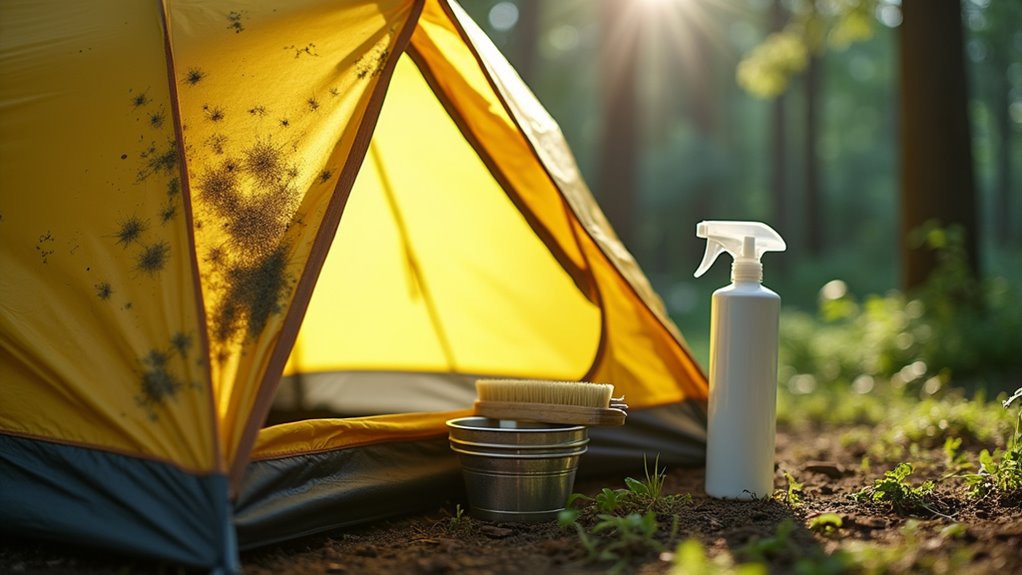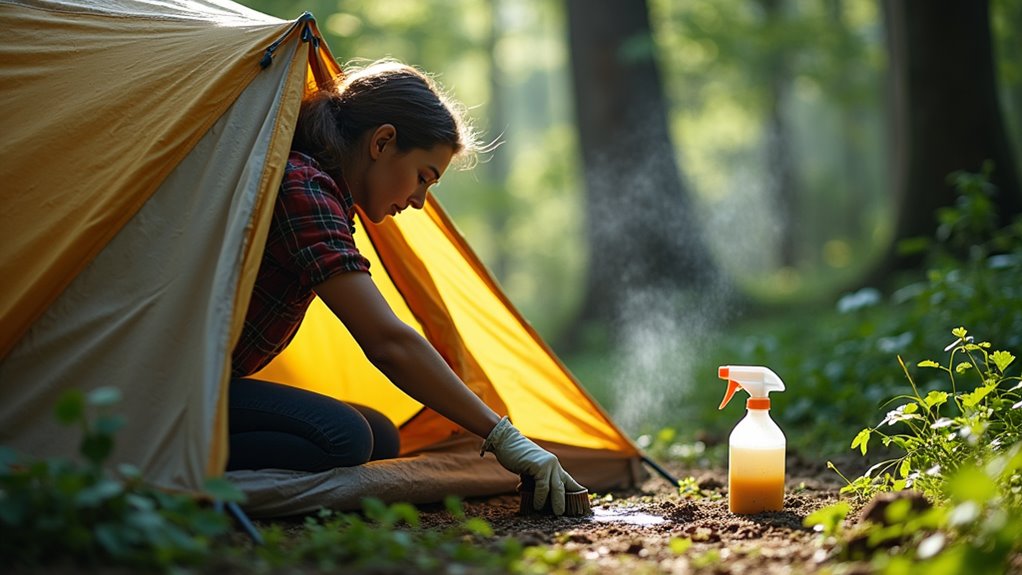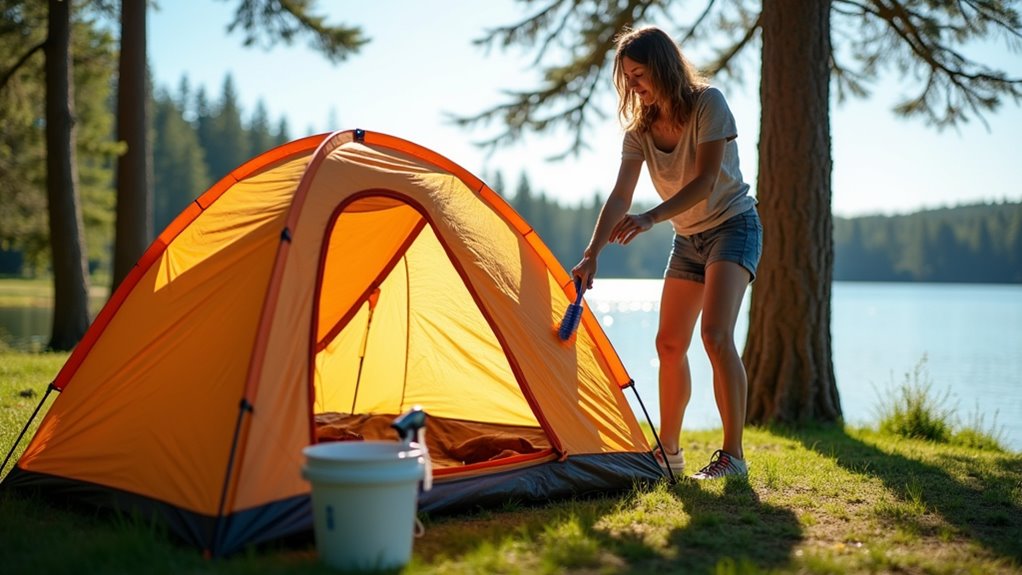How To Clean Mildew Off Tent
This post contains affiliate links. As an Amazon Associate, we earn from qualifying purchases.
To clean mildew off your tent, use a mild soap mixed with cold water to gently scrub the affected areas, then rinse thoroughly and dry completely before storing. For tougher stains, cleaning vinegar or hydrogen peroxide can be effective. Further explanation and additional tips to keep your tent in top shape are provided below.
Essential Facts in 30 Seconds
- Clean mildew using mild soap mixed with cold or lukewarm water and a soft sponge or cloth.
- Use natural treatments like vinegar, lemon juice, or hydrogen peroxide to remove mildew and stains.
- Rinse the tent thoroughly after cleaning to eliminate soap residue.
- Dry the tent completely before storing to prevent moisture and mildew growth.
- Inspect and clean the tent regularly to maintain its condition and prevent mildew.
Identifying Mildew on Your Tent

Before your next camping trip, check your tent for mildew.
Mildew looks like flat, powdery patches. These patches usually appear white or gray. They don’t look fuzzy. Focus on seams, zippers, and folds. These parts hold moisture and mildew grows there.
Smell the tent. A musty odor means mildew might be present. This smell gets stronger in humid places. Regularly cleaning the tent helps prevent mildew growth.
Touch the fabric. Wet or powdery spots show mildew. High humidity and poor airflow help mildew grow.
Watch for color changes, bad smells, or rough fabric. Fix these problems before camping. Spotting mildew early protects your tent and makes camping better.
Additionally, it’s important to address mold or mildew promptly to prevent further damage.
Cleaning Methods and Solutions
Cleaning mildew from your tent is simple with the right methods.
Use mild soap and water for light cleaning.
Vinegar and lemon juice work well on tougher mildew spots. Additionally, consider using a vinegar solution to effectively remove and prevent future mold growth.
Enzyme-based cleaners break down mold and stop it from coming back.
These solutions keep your tent fresh and safe to use.
Try each method carefully to protect your tent fabric. Additionally, be sure to rinse tent thoroughly after cleaning to remove any residue that could cause damage.
Mild Soap Solutions
Mild soap solutions clean mildew on tents without harming the fabric. Mild soap is gentle and protects your tent while removing mildew effectively.
Mix a small amount of mild dish soap with cold or lukewarm water. Use a soft sponge or cloth to scrub the mildew spots carefully. Avoid soaking the fabric too much.
Rinse the tent well to remove all soap. Soap left on the fabric can cause more mold to grow. A clean tent looks good and lasts longer.
Take your time and clean it with care. Regular checks for dampness can prevent future issues with mildew.
Natural Remedies Overview
Mild soap solutions work well for early mildew problems.
Natural remedies offer extra ways to clean your tent safely. Mix ½ cup of cleaning vinegar with one gallon of water. Use a soft brush to apply it, then wait ten minutes before rinsing.
Lemon juice and salt make a strong stain remover. Hydrogen peroxide kills mold quickly. Tea tree oil fights fungus when mixed with water.
Baking soda cleans gently and removes bad smells. These natural options keep your tent strong and mildew-free.
Specialized Cleaners Benefits
Specialized cleaners remove mildew from tents better than regular soaps. They target stains while keeping fabric safe and strong. Use the right cleaner for the best results. Here are some options:
| Type of Cleaner | Benefits | Example Products |
|---|---|---|
| Enzyme Cleaners | Break down mildew without damaging fabric | MiraZyme™ |
| Mildew Stain Removers | Remove tough fungal stains quickly | Iosso Mold and Mildew Stain Remover |
| Vinyl-Specific Cleaners | Protect vinyl tents and fight mildew | Dynamite Vinyl Shine |
| Professional Solutions | Deep clean and keep water resistance | Revivex Pro Cleaner |
Special cleaners work fast and keep your tent looking new. Use them to protect your gear and enjoy the outdoors safely.
Step-by-Step Cleaning Process
Cleaning mildew off a tent takes care and the right steps. Gather mild soap, Nikwax Tech Wash, a soft brush, and a large tub. Fill the tub with cold or lukewarm water. Submerge the tent and rainfly. Add half the soap amount recommended on the label. Stir the water gently to spread soap evenly. Let the tent soak for several hours or overnight.
Rinse the tent well with clean water to wash away the soap. Mildew might still be there. Use an enzyme cleaner like MiraZyme next. Follow the instructions on the product for best results. It’s important to ensure the tent is completely dry after cleaning to prevent future mildew growth.
No enzyme cleaner? Mix half a cup of vinegar with a gallon of water. Scrub the mildew spots softly with the brush. Leave the tent to dry in the sun. Regular cleaning and maintenance can help prevent mold growth and keep the tent safe and strong for many adventures.
This method kills mildew and helps stop it from coming back. It keeps the tent safe and strong for many adventures.
Handling Stubborn Stains and Contaminants

Stubborn stains like pine sap or dirt can harm your tent fabric. Use mineral oil or isopropyl alcohol to remove sap. Apply it gently. Avoid scrubbing hard. Additionally, cleaning with vinegar can be an effective method for removing mold from various surfaces, including tents. Dirt in zippers can block their movement. Use a soft toothbrush to clean zippers well. Rinse thoroughly after cleaning. This keeps zippers working smoothly.
Additionally, maintaining cleanliness and regular checks can help prevent future mold growth. Clean tents last longer and stay strong. Simple care makes a big difference.
Pine Sap Removal Techniques
Pine sap leaves sticky stains on your tent after camping near pine trees.
Freeze the sap with ice cubes to harden it. Then, gently scrape off the hardened sap using a scraper or your fingernail.
For fresh sap, apply mineral oil, WD-40, or rubbing alcohol. These liquids break down the sticky sap well.
Stubborn stains respond to peanut butter because its oils dissolve sap.
Clean the area with a mild soap and water to remove all residue.
Sprinkle talc powder on the spot to stop sap from sticking again.
These simple steps keep your tent clean and ready for your next trip.
Zipper Dirt Cleaning Tips
Keep tent zippers clean to make them last longer and work smoothly. Dirt can block zipper teeth and cause jams.
Use a soft brush, like a toothbrush, to brush away dirt gently. Rinse zippers with cool water to wash out small debris. Open and close the zipper fully while rinsing for best results.
For rust or corrosion, mix white vinegar with hot water. Scrub the zipper carefully with a small brush. Dry the zipper well after cleaning.
Spray a dry, water-repellent lubricant like McLube™ Sailkote on the zipper. This reduces friction and stops the zipper from sticking.
Clean zippers often to avoid damage and keep them working well.
Avoiding Fabric Damage
Avoid damaging your tent fabric by using gentle cleaning methods.
Use mild cleaners like Revivex Pro Cleaner or McNett MiraZyme. These keep your fabric safe and protect waterproof layers.
Natural mixes of salt, lemon juice, and hot water fight mildew without harm. Soft-bristle brushes work best for scrubbing.
Avoid harsh scrubbing, especially on polyurethane-coated areas. Clean spots instead of scrubbing the whole tent.
Dry your tent in the sun until completely dry. Apply a water repellent after cleaning to restore protection and extend the fabric’s life. Regular maintenance can help prevent zipper issues and keep your tent strong and ready for many trips.
Preventative Measures Against Mildew

Prevent mildew in your tent by taking clear and simple steps. Use tents made from breathable fabrics with mildew-resistant coatings.
Always dry your tent fully before putting it away. Store it in a dry place, never a damp one. Use mesh or breathable bags for storage.
Check your tent often for mold or color changes. After cleaning, apply waterproof and mold-preventive sprays.
Keep air flowing by leaving vents and zippers open a little during use. These actions reduce mildew risk and keep your tent fresh.
On-the-Go Tips for Tent Maintenance
Enjoying the outdoors means taking good care of your tent. Clean your tent after every trip. Use cool water and a soft sponge to scrub mildew spots. Avoid hard brushes; they can hurt the fabric. Mild soap, like Dr. Bronner’s castile soap, works well for cleaning.
Store your tent only when it’s dry. Use mesh sacks that breathe, not tight stuff sacks. This stops moisture from building up inside.
Dry your poles separately after rinsing. Make sure all parts are dry to stop rust and damage.
Keep your tent’s zippers free from dirt. Brush off any debris to prevent jams and wear.
Check your tent and poles often. This simple care helps your gear last longer and keeps your camping fun.
Frequently Asked Questions
Can I Use Bleach to Clean Mildew off My Tent?
Bleach can harm your tent fabric and cause colors to fade. Use special mildew cleaners or hydrogen peroxide instead. These options clean mildew safely without damage. Keep your tent dry and well-ventilated to stop mildew from growing. Air it out after each trip. Store it in a cool, dry place. Good care helps your tent last longer and stay strong.
How Often Should I Inspect My Tent for Mildew?
Check your tent for mildew often. Mildew grows fast in damp places. Inspect your tent at least every 3 to 6 months. Monthly checks work best if you use the tent a lot. Clean and dry your tent after each trip. This keeps mildew away and makes your tent last longer. Don’t wait until you see spots. Early checks stop problems before they start. Keep your tent fresh and ready for your next adventure.
Will Mildew Damage My Tent’s Waterproof Coating?
Mildew can ruin your tent’s waterproof coating. It breaks down the material that keeps water out. This causes leaks and weak spots. Studies show damp conditions speed up mildew growth. Keep your tent dry by airing it out after use. Clean off dirt and moisture quickly. Use waterproof sprays to protect the fabric. These steps help your tent last longer and stay dry. Don’t let mildew damage your gear. Act fast to keep your tent strong.
Can I Machine Wash My Tent to Remove Mildew?
Machine washing a tent can ruin its waterproof coating. This damage makes the tent less safe in rain. Mildew on tents needs gentle care. Use a soft brush or cloth with mild soap. Rinse well with clean water. Dry the tent fully in sunlight to stop mildew growth. Keep tents clean and dry to avoid mildew problems. This method keeps your tent strong and ready for camping.
How Can I Tell if Mildew Is Still Present After Cleaning?
Mildew often leaves stains and smells that don’t go away easily. Check fabric closely for spots or color changes. Smell the area for a musty odor. Feel the fabric for dampness or rough patches. Pay attention to corners, seams, and folds where mildew hides. If any signs stay, clean again to prevent damage. Dry the fabric completely to stop mildew growth. Regular checks help keep mildew away for good.
Conclusion
Keeping your tent clean helps it last longer and keeps you comfortable. Check your tent often for mildew. Use simple cleaning methods like wiping with vinegar or special tent cleaners. These products remove tough stains and kill mildew. A clean tent smells fresh and stops allergens from bothering you. Take good care of your tent. It will protect you on every trip. Clean gear means happy camping!
